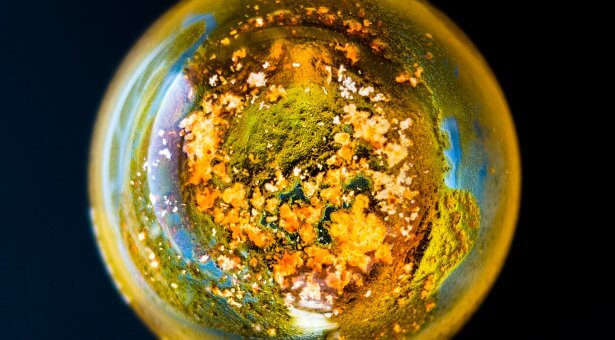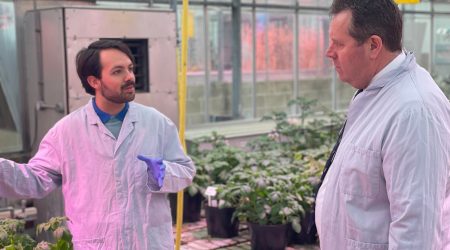What are microbes and where are they found?

Alongside plant research, at the John Innes Centre we are focused on understanding microbiology.
Products made by plants and bacteria are essential for humankind, and integral to our daily lives. That’s why, our Institute Strategic Programme Molecules from Nature investigates the vast diversity of chemicals (natural products) made by plants and microbes.
For example, Streptomyces makes lots of specialised metabolites that are widely used in human medicine as antibiotics, immunosuppressants, antiparasitic and anticancer drugs.
PhD student Kathy Stratton, works with Dr Susan Schlimpert on understanding Streptomyces venezualae and specifically how cell division in Streptomyces is controlled in response to DNA damage.
We asked Kathy, what are microbes, why are they interesting and where do you find them?
“It would be better to ask where you don’t find microbes because they have been found almost everywhere on Earth and even on the International Space Station.
Microbes have been around for approximately 3.5 billion years, meaning they have evolved to survive in a huge variety of habitats.
Also known as microorganisms, they are small, microscopic organisms, such as bacteria, but there are other organisms that fall under the characterisation of “microbe”, like archaea, protozoa, and some fungi.
Scientists are making surprising discoveries about microbes all the time. For example, in 2016, a “superbug” was discovered 1,000 feet underground, in a cave in New Mexico. The bacterial species was found to be resistant to 26 out of 40 antibiotics tested – despite being isolated from the rest of the world for 4 million years. This discovery suggests the mechanisms by which bacteria avoid being killed by antibiotics have existed for millions of years, before humans started using antibiotics in medicine.
Bacteria and archaea have also been found near deep-sea hydrothermal vents, which is an environment with extremely high temperatures and tremendous pressure. In fact, an archaeal species known as “strain 121”, found near hydrothermal vents, can reproduce at 121°C and is still viable at 130°C.
As well as at the bottom of the ocean, bacteria have been discovered in ancient ice in Alaska. This has highlighted the possibility of extra-terrestrial life in the glaciers on Mars or the frozen seas of Jupiter’s moon, Europa.
These microbes that can survive extreme environments are called extremophiles and are useful in industrial processes because they can catalyse reactions in harsh conditions. For example, the archaea Sulfolobus solfataricus is used to break down dangerous organophosphorus compounds, and as it is used to living in volcanic pools, this microbe is very robust.
Microbes have even been found in the clouds, where they can help the clouds precipitate to make rain or snow. For a cloud to produce rain or snow, there needs to be tiny particles which serve as a nuclei for condensation. Often, these particles are of mineral origin, but airborne microbes have been found to do this job too, and some microbes have adapted to withstand UV radiation, enabling them to survive in the atmosphere.
As well as in the skies above us, microbes live in the soil.
Streptomyces are one-such soil-dwelling bacteria which produce antibiotics, these are chemical substances used to fight off competing bacteria.
These antibiotics are also used when we get bacterial infections and, over half of the world’s antibiotics discovered are from Streptomyces. Another interesting thing about Streptomyces, is that they produce a compound called geosmin which is behind the smell produced when rain hits soil.
As well as extreme environments, microbes live on and inside our bodies. This community of microbes makes up our microbiota – everyone’s is unique, like our DNA or fingerprints.
For example, you may have heard of the bacteria Lactobacillus which is put into some yogurt. This bacteria lives in our gut and helps us digest milk and fight off pathogens.
We also have microbes on our skin, some of which digest sweat, making it smell. It is estimated that a massive 100 million bacterial cells live on and in our bodies, ten times more bacterial cells than human cells.
As well as helping us, microbes can be dangerous and can cause disease in humans, animals, and plants.
The most fatal pandemic in human history – the “black death”, was caused by the bacterium Yersinia pestis. Tuberculosis is caused by the bacterium Mycobacterium tuberculosis and in 2018, killed 1.5 million people. Malaria is a protozoan parasite microbe. It requires a human host to reproduce, and a mosquito host to transmit between humans.
Interestingly, archaea are also part of our microbiota, but so far, no pathogenic species have been identified.
There is controversy over whether viruses count as microbes, as a microbe is a living thing, and viruses are often classified as non-living. Viruses are found in most environments, and can infect humans, animals, plants and even bacteria.
Microbes are almost everywhere, below our feet, above our heads and in our bodies. Some are dangerous to us, but most are beneficial. More than 99% of bacteria are unculturable so we cannot grow them in a lab to study them. This means there are many more incredible species to discover, and useful research still to do.”
Kathy’s PhD is funded by The Royal Society.



